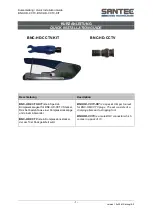
Schilling Marking Systems GmbH
In Grubenäcker 1 DE-78532 Tuttlingen
+49 (0)7461 9472-0
+49 (0)7461 9472-20
www.schilling-marking.de
Bedienungsanleitung SIGNOMAT S100
Updated: 04/2014
Operating instructions SIGNOMAT S100
Mode d´opération SIGNOMAT S100
12
Probelauf:
Legen Sie das Werkstück ein und prüfen Sie, ob
Sie mit den Einstellungen zufrieden sind. Stellen
Sie die Signierzeit und Signierart, wie dort
beschrieben, am betriebsbereiten Signomat ein.
Betätigen
Sie
den
am
Signomat
angeschlossenen Fußschalter und lösen Sie
eine Probesignierung aus. Sind Sie zufrieden,
nehmen Sie die Serienfertigung auf. Andernfalls
nehmen Sie die nötigen Änderungen an den
Einstellungen vor oder prüfen Sie, ob Ihnen die
unter Abschnitt „Verbesserung der Signierung“
genannten Hinweise weiterhelfen können.
Ende der Signierung:
Durch Betätigen des Schalters 40 (<< Rücklauf)
an der Elektrolytpumpe, wird das noch im
Elektrolytschlauch und im Filz verbliebene
Elektrolyt
wieder
in
den
Behälter
zurückgepumpt. Geräte abschalten. Den Filz 51
vom Stempel 50 entfernen und beides mit
Wasser
gut
durchspülen.
Bei
Arbeitsunterbrechungen über mehrere Tage den
Elektrolytschlauch mit Wasser durchspülen.
11) Verbesserung der Signierung
Vor dem ersten Signieren ist die Schablone
ohne Strom mit Elektrolyt benetzen. Ein
trockener Filz verhindert den Stromfluss, die
Signierung wird sehr schlecht. Eingetrocknetes
Elektrolyt und Neutralyt versalzen die Maschine,
dadurch ist der Stromfluss behindert. Die
Signierung wird schlecht. Deshalb ist reinigen
mit
klarem
Wasser
täglich
Pflicht.
Die
Schablonen müssen regelmäßig und behutsam
zwischen zwei Fingern unter Wasser gesäubert
werden,
da
sie
durch
Metallrückstände
verschmutzt werden. Auch den Stempel und die
Werkstückaufnahme regelmäßig mit Wasser
reinigen. Bei starker Verschmutzung ist sie mit
Schilling Schleifreiniger (Art.Nr: 22.165) zu
behandeln.
Sorgen Sie dafür, dass Ihnen für Ihr Metall der
richtige Elektrolyt zur Verfügung steht (siehe
beiliegende Tabelle). Bestimmte Materialien,
z.B. Hartmetall, müssen mit Konservat K1
(Art.Nr: 22.111) geschützt werden. Kleine
Flächen
durch
einfache
Andrucktechnik
signieren. Große Flächen von Hand mit
Abstreichtechnik signieren. Ein Betriebsdruck
von 2-4 bar am Pneumatikaufbau bringt gute
Ergebnisse. Höheren Druck dort nur bei
größeren Signierbildern verwenden.
Die Schablone darf sich nicht zu stark
erwärmen, da sie sonst vorzeitig verschleißt
oder der Elektrolyt verdampft. Bei Signierzeiten
ab 5s treten Temperaturen von 120°C und mehr
in der Schablone auf. Das Signierbild wird
schlecht und die Schablone „wellt“ sich. Die
Schablone muss ausgetauscht werden. Im
Normalbetrieb haben die Langzeitschablonen
eine Standzeit von 2000-3000 Signierungen.
Gedunkelte Filze regelmäßig ersetzen. Der
Filz dunkelt umso mehr, je größer das
Signierbild ist.
12) Kurzschluss und Überlast
Der
Signomat
besitzt
eine
elektronische
Signierstromüberwachung. Sie schaltet, bei
Kurzschluss oder Überlast, den Signierstrom
innerhalb von Sekundenbruchteilen ab und löst
ein akustisches und optisches Warnsignal 3
aus. Nach fünf Sekunden ist das Gerät für die
nächste Signierung wieder einsatzbereit.
Eine Netzsicherung befindet sich auf der
Platine. Sollte diese durchgebrannt sein muss
das Gerät im Werk überprüft werden. Prüfen Sie
grundsätzlich die Netzverbindung. Sollte kein
Signierstrom fließen, ist zu prüfen, ob die Kabel
durch Abknicken unterbrochen sind; dann sind
die Kabel sofort durch original Schilling
Ersatzkabel auszutauschen.
Test run:
Position the workpiece and check the settings.
When the Signomat is ready for operation, set
marking time and type of marking as described in
the corresponding paragraphs. Activate the foot
switch connected the Signomat and start a trial
marking procedure. If the result meets your
requirements, serial production can be started. If
this is not the case, change the settings as
required or check whether the tips given in the
section „improving marking results“ would be of
help.
End of marking procedure:
When switch 40 (<<return) of the electrolyte
pump is activated, the electrolyte remaining in
the electrolyte hose and felt piece is pumped
back into the container. Switch off machine.
Remove felt piece 51 from stamp 50 and rinse
both thoroughly with water. If work is to be
interrupted for several days, rinse the electrolyte
hose with water.
11) Improving marking results
Before the first marking procedure, moisten the
stencil with electrolyte when current is switched
off. Dry felt impedes current conduction, and the
resulting
mark
is
extremely
poor.
Dried
electrolyte and Neutralyt result in salt deposits in
the
machine;
this
also
impedes
current
conduction, causing poor marking results. For
this reason, daily rinsing with clear water is
necessary. Stencils soiled by metallic residue
must be cleaned carefully and at regular
intervals. To do this, hold the stencil carefully
between two fingers under water and clean. The
stamp and work piece receiver must also be
cleaned with water at regular intervals. In case of
extreme soiling, clean with Schilling abrasive
cleaner (Art. No: 22.165).
Ensure that the electrolyte suitable for the metal
to be marked is on hand. Certain materials, e.g.
hard metal, must be protected by preserving
agent K1 (Art. No: 22.111). Mark small surfaces
using the simple pressing method. Mark larger
surfaces manually using the stroking method. A
working pressure of 2-4 bar in the pneumatic
work holder provides good results. Use higher
pressures only for larger marking images.
To avoid premature wear and to prevent the
electrolyte from evaporating, the stencil should
not be heated excessively. Using marking times
over 5s causes the material of the stencil to gum
up to temperatures of over 120°C. This causes
poor marking results and stencil turns “wavy”.
The stencil must than be replaced. In normal
operation, the stencils with long service life are
good for 2000-3000 marking procedures. Felt
which has darkened must be replaced at
regular intervals. Darkening of the felt
increases with the size of the marking image.
12) Short circuits and overcharge
The Signomat is equipped with an electronic
controller of the marking current. In case of a
short circuit or overcharge, it switches off the
marking current within fractions of a second and
triggers an acoustic and optical warning 3 signal.
After five seconds, the machine is ready to be
used for the next marking.
The board is equipped with a mains fuse. Have
the machine checked by Schilling in case that
this fuse is burnt. Generally check the mains
connection. Should no marking power be
available, check whether the cables are kinked
and therefore interrupted. If so, immediately
replace cables with original Schilling replacement
cables.
Essai:
Introduisez la pièce à marquer et contrôlez si
vous obtenez des réglages satisfaisants. Réglez
la durée de marquage et le type de marquage,
conformément à la description, sur le Signomat
prêt à fonctionner. Actionnez l´interrupteur à
pédale raccordé au Signomat et enclenchez un
marquage d´essai. Si vous êtes satisfait du
résultat, commencez la fabrication en série.
Dans le cas contraire, effectuez les modifications
nécessaires aux réglages ou contrôlez si les
informations contenues dans le paragraphe
„amélioration du marquage“ peuvent vous
apporter une aide.
Fin du marquage:
En actionnant le commutateur 40 (<<retour) sur
la pompe, l´électrolyte resté dans le tuyau flexible
à électrolyte et dans le feutre est repompé dans
le réservoir. Arrêter l´appareil. Retirer le feutre 51
du tampon 50 et rincer abondamment les deux
éléments à l´eau. En cas d´interruption de travail
pendant plusieurs jours, rincer le tuyau flexible à
électrolyte avec de l´eau.
11) Amélioration du marquage
Avant le premier marquage, humidifier le pochoir
avec l´électrolyte, sans courant. Un feutre sec
empêche le flux du courant, le marquage est très
mauvaise qualité. De l´électrolyte et du neutralyte
séchés sur la machine, empêche le courant de
s´écouler. Le marquage est alors de mauvaise
qualité. Pour cette raison, il faut effectuer un
nettoyage quotidien avec de l´eau claire. Il faut
nettoyer régulièrement et avec précaution les
pochoirs en les maintenant sous l´eau avec deux
doigts, étant donné qu´ils peuvent être salis par
des restes de métal. Nettoyer également sous
l´eau le tampon et le support de pièces. Dans le
cas où ils sont très sales, les traiter avec le
gomme nettoyante Schilling (Art.No.: 22.165).
Veillez à disposer de l´électrolyte appropriée
pour votre métal (voir tableau sur page 16).
Certains matériaux, comme par ex. le métal dur,
doivent être protégés avec un produit de
conservation K1 (Art.No.: 22.111). Marquer les
petites surfaces en utilisant une technique
d´application simple. Marquer les surfaces de
grandes dimensions, à la main, en utilisant la
technique
d´application.
Une
pression
d´exploitation de 2-4 bar, à l´unité pneumatique,
donne de bons résultats. Utiliser une pression
plus élevée uniquement pour les marquages de
plus grandes dimensions.
Le pochoir ne doit pas se réchauffer trop
fortement sinon il s´use prématurément ou
l´électrolyte s´évapore. Des temps de marquage
dépassant 5s comportent un échauffement
dépassant 120°C sur le pochoir et le tissu du
pochoir colle. Le marquage est alors de
mauvaise qualité. Il faut remplacer le pochoir.
Dans des conditions d´exploitation normales, les
pochoirs de longue durée ont un temps
d´utilisation permettant d´effectuer 2000-3000
marquages. Remplacer régulièrement les
feutres encrassés. Plus le marquage est
grand, plus le feutre s´encrasse.
12) Court-circuit et surcharge
Le Signomat a un contrôle électronique du
courant de marquage. Il coupe le courant de
marquage depuis une fraction d’une seconde en
cas d’un court-circuit ou d’un surcharge. Un
signal acoustique et optique 3 est déclenché.
Après 5 seconds, la machine est prête pour le
prochain marquage. Sur la platine se trouve un
fusible de secteur. En cas d’une combustion de
ce fusible, le Signomat doit être contrôlé par
Schilling. En générale, il doit contrôler le
raccordement de réseau. S´il n´y a pas de
courant pour le marquage, contrôlez si les câbles
ne sont pas pliés ou rompus; il faut alors aussitôt
remplacer les câbles par des câbles de
remplacement d´origine, de la société Schilling.








































